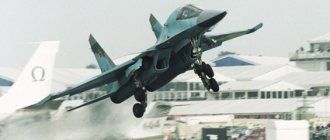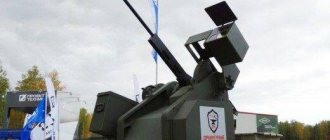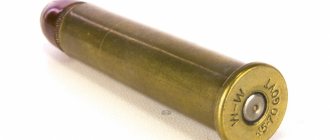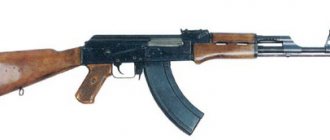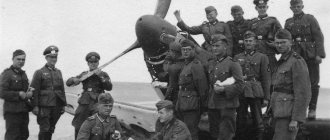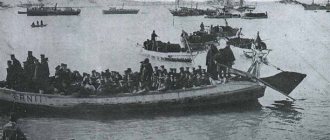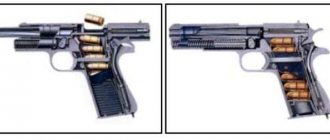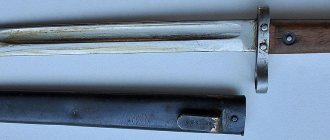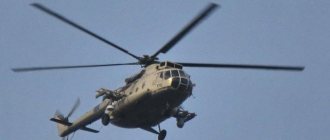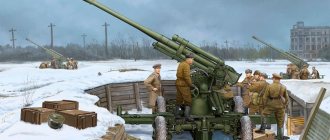headlight
- a family of Russian portable continuous-wave radar stations.
Designed for radar surveillance of terrain, reconnaissance and identification of targets, as well as guidance of various weapons (machine guns, grenade launchers, etc.) at detected targets, including in conditions of lack of optical visibility. Developed and produced by NPO Strela of the Almaz-Antey concern.
There are 3 modifications of the radar:
- The basic product is the 1L111 short-range reconnaissance station SBR-3 "Fara-1"
. - Development of "Fara-1"
-
"Fara-PV"
. - Development of Fara-PV
-
Fara-VR
. First presented at MAKS-2011.
Modifications
Headlight-1
"Fara-1" is designed to detect targets, as well as aim various weapons at them - including machine guns, grenade launchers and armored vehicles. The complex ensures effective engagement of targets in conditions of poor optical visibility.
The Fara-1 complex additionally includes: a compass, a storage box, a polarizer and a specialized mount for attaching the antenna to a weapon (various for pointing machine guns, grenade launchers, guns, or for attaching to surveillance equipment).
Fara-PV
"Fara-PV" is a short-range radar station with a panoramic viewing device. It is designed to conduct round-the-clock monitoring of the movement of people and equipment in hard-to-reach areas, as well as in conditions of limited visibility. The coordinates of detected targets can be transmitted to army weapons.
The Fara-PV complex additionally includes an optical sight.
Battlefield reconnaissance radar
The armies of many countries around the world have so-called battlefield radars (radar stations) - ground reconnaissance, designed to detect enemy personnel and military equipment. Intensive development of these radars began during the Vietnam War and the Arab-Israeli wars, when the experience of their combat use by the Americans and Israelis showed the high effectiveness of the radar, especially at night, in conditions of poor visibility and in dense vegetation.
The main purposes of ground reconnaissance radar are:
- detection and observation of the movement of enemy troops and military equipment on the battlefield;
- protection of certain boundaries, areas or objects from enemy penetration;
- ensuring firing adjustments to detected enemy personnel and military equipment;
- control the movement of friendly troops and patrols equipped with radar detection devices with a transponder emitting coded signals identifying friendly forces.
Portable and portable small-sized ground reconnaissance radars are especially widely used, having high mobility, short deployment time, ease of maintenance, the ability to be remotely controlled using remote control and display panels, the ability to be used at any time of the day and in various visibility conditions, high resolution and reliability .
Most ground reconnaissance radars use Doppler coherent mode of operation with continuous radiation, modulation and correlation signal processing. This makes it possible to eliminate dead zones at short ranges, increases the noise immunity and secrecy of the radar operation, and also provides high resolution. However, radars using these modes do not detect stationary targets. Therefore, some ground reconnaissance radar stations use a pulse-Doppler incoherent operating mode, which ensures the detection of not only moving, but also stationary ground targets. At the same time, a significant disadvantage of radars operating in this mode is the presence of a dead zone within a radius of 50-80 meters.
The general disadvantages of most ground reconnaissance radars include the ability to detect their operation by the enemy at ranges exceeding the range of these radars, the dependence of the installation location on the topographic conditions of the area, the difficulty of recognizing detected targets, sensitivity to precipitation and interference caused by swaying tree branches and grass, and They are also more susceptible to enemy electronic countermeasures.
Based on their range, all types of ground reconnaissance radars in NATO countries are divided into short-, short-, medium- and long-range stations.
Armies around the world currently have more than 80 different types and modifications of ground reconnaissance radars, including American - 28, French - 22, British - 13, CIS countries - 8, Italian - 3, Israeli and Danish - 2 each. , German, Canadian, Spanish, Swedish, Dutch, Belgian, Turkish, former Yugoslav and Chinese - 1 each.
The foreign press reported that a Russian motorized rifle division has 12 PSNR-2 radars, a tank division has 9, an airborne division has 2, and each division has 11 PSNR-3 regimental radars.
Based on NATO standards for tactical reconnaissance zones in depth and front, it can be assumed that ground reconnaissance radars are used:
- short-range - in companies (reconnaissance area 8x5 km);
- medium range - in battalions (15x10 km);
- medium and long range - in brigades (75x30 km).
Short-range radars are used in reconnaissance, patrol and patrol units, as well as in platoons.
The most popular radars in production are: in the USA - AN/PPS-4В, -5С, -5В, -5D, -6, -15А, in France - Razit, Oliphant-2, Rasura, in the UK - GS 14 Mkl (former ZB-298), in Italy - Sentinel. A number of countries that do not have ground reconnaissance radars of their own production have adopted foreign models into service with their ground forces. Ground reconnaissance radars operate in two frequency bands: 390-1550 and 5200-36000 MHz, with the most commonly used ranges being 8000-10900 (up to 80% of all radars) and 15350-17250 (15%) MHz. In the range of 390-1500 MHz, short-range radars designed to detect targets in dense vegetation operate - AN/PPS-14, Fopen 1A, Folpen BSD, Camp Sentinel radars.
Ground reconnaissance radars, in addition to sound and light indication of smelt detection, can have indicators on cathode ray tubes, mosaic type and digital, allowing you to determine the azimuth with an accuracy of 0.5-1.4 and the range depending on the distance - from 8 to 25-50 m Some radars (AN/PPS-17, Razit, Rasura, Arabella) have a system for identifying friendly troops. For these purposes, transceivers are used (American AN/PPS-502, French Sirius, Canadian Microdet).
Most ground reconnaissance radars have a cable remote control system, which allows the radar operator to be in a shelter at a distance of 10 to 100-300 m.
According to the operating position of the ground reconnaissance radar, the following can be used:
- as manual (AN/PPS-9, -1 K -12, -13, -14, Fopen 1A, All Kot Mkl 1);
- on the operator's chest (AN/PPS-10, -17, GS 18 Mkl, Shrimp, Astrid, Oliphant-2, Arabelle);
- on a tripod (AN/PPS-5, -15, -17, -18, Astrid, GS 14 Mkl, GS 18 Mkl, Shrimp, Scampi, Rasura, Oliphant-2, -2M, Razit-72, Rapier, Sentinel, PVSS , UAF-403Gi, Squize).
Some radars can be installed on vehicles or military equipment (Rasura, Ratak, Repace, Oliphant-2M, Camp Sentinel, AN/TPS-58, GS 14 Mkl, PVSS) or deployed as stationary ones (Folpen V).
The radars, carried out in two versions: on a tripod and as patrol ones on the operator’s chest, differ in layout, weight and autonomy (Shrimp, Oliphant-2, -2M, GS 18 Mkl, Arabelle). Hand-held radars (AN/PPS-9, -11, -12, -13) can be used as radar sights on small arms.
In addition to detecting infantry and equipment, some ground reconnaissance radars can also detect low-flying air targets - helicopters, unmanned aerial vehicles at ranges from 5 to 30-60 km (AN/TPS-74, SCAT-20, RB 12B, Ratak, Ratak-53, Razit-E, Stentor, BOR-A550).
Currently, further development of ground reconnaissance radars is carried out in the areas of complete automation of the processes of search, detection, recognition, determination of coordinates and display of targets, as well as the further development of individual radars with a system for identifying friendly forces and detecting in dense vegetation.
In the USA, the most widely produced ground reconnaissance radars were AN/PPS-4B (more than 2000 units produced), AN/PPS-5 (more than 2000 units), AN/PPS-15 (858 units), AN/PPS-6 (600 units). The number of other radars is in the dozens. By 2000, the US Army had more than 1000 AN/PPS-5B radar units and 800 AN/PPS-15A radar units. Besides the USA, AN/PPS-15A radars were delivered to Argentina (170 units), Canada (215), Iceland (150), Norway (25), UN (40), as well as Israel and Taiwan. 300 AN/PPS-5B radars, which are no longer produced, were also exported. However, modifications of the AN/PPS-5D continue to be produced, used by special forces and to guard Air Force facilities, as well as in Iraq at checkpoints.
To detect targets in dense bush, forest and tall grass, where the use of other ground reconnaissance radars is difficult or impossible, the US Marine Corps uses portable but permanently installed Folpen radars, which have transmitting and receiving discrete antennas in the form of phased array antennas and a control unit and indication, connected to the antennas by cable, which allows the operator to be in a shelter at a distance from the antennas. A complete radar set weighs no more than 13.6 kg, can be carried and serviced by one person, and can be deployed and collapsed in no more than 12 minutes. The radar allows you to detect a single person walking in dense foliage at a distance of 300 m, and in open areas - 1500 m and a jeep-type vehicle in dense foliage at a distance of 500 m. The resolution of the radar in range is 15 degrees and in azimuth 5 degrees. The viewing sector is 120 degrees.
American radars AN/PPS-9 and AN/PPS-10 are also in service with Germany.
| Some models of battlefield reconnaissance radar | |||||||||
| Type | Carrier frequency, GHz | Radiation power, W | Detection range, m | Determination accuracy distances m | Weight, kg | Calculation, people | Deployment time min. | ||
| Human | Military equipment | ||||||||
| Short range | |||||||||
| AN/PPS-15 | 9-9,5 | 0,06 | 1500 | 3000 | 10 | 10,7-15 | 2 | 2-3 | |
| AN/PPS-17 | 9-9,5 | 7,5 | 1500 | 3000 | n/a | 12,3 | 1 | 2 | |
| AN/PPS-18 | 9-9,5 | 4,5 | 1500 | 3000 | n/a | 15,8 | 2 | 2-3 | |
| R-2010 | 9-9,5 | 1000 | 5000 | 10000 | 25 | 13,3 | 1 | 2 | |
| Oliphant-2 | 15,35-17,25 | 0,04 | 1800 | 2500 | 1,5 | 9 | 3 | 1 | |
| Short range | |||||||||
| AN/PPS-5 | 16-16,5 | 1000 | 500 | 10000 | 20 | 12,8 | 1-2 | 7-10 | |
| GS 14 Mk1 | 15,35-17,25 | 3000 | 5000 | 10000 | 20-25 | 26 | 2 | 3 | |
| Medium range | |||||||||
| AN/PPS-25 | 9-9,25 | 1000 | 8000 | >20000 | 23 | 15,9 | 2 | 3 | |
| AN/TPS-58 | 9,4-9,6 | 8000 | 10000 | 20000 | 10-20 | 45 | 3 | n/a | |
| Razit-E | 9,5-9,7 | 3000 | 23000 | 40000 | 10 | 90 | n/a | n/a | |
| Long range | |||||||||
| Orpheus | n/a | n/a | n/a | 60000 | n/a | 150 | n/a | n/a | |
| AN/TPS-74 | 9,4-9,6 | n/a | n/a | 20000 | n/a | n/a | n/a | n/a | |
The English short-range radar CS 18 Mkl Prowler is an infantry company radar and is available in man-portable (patrol) and portable (on a tripod) versions. In the patrol version, the radar weighs 4.5 kg (including a 24-volt battery with a capacity of 1.1 A/h), and the complete set (without batteries) weighs 8 kg, is serviced by one operator and deploys in one minute. The portable version weighs 11.5 kg (according to other sources 13.5 kg) is serviced by two operators and deploys in 2 minutes.
Another English short-range radar, Shrimp, is also in service with infantry companies and is available in two versions. The patrol version is worn on the chest, serviced and deployed by one operator in 1 minute, and weighs 3.5 kg, including a 1.1 A/h battery. The portable version kit includes a tripod, a portable container, batteries and has a total weight of 8.5 kg. The radar is powered by a 24-volt battery weighing 0.6 kg with a power of 3 A/h for 15 hours.
The GS 14 Mkl radar is in service with Denmark, the Netherlands and other NATO countries.
The French radar Oliphant-2 (DR-PT-6) is also available in patrol and portable versions. In the patrol version, the radar weighs 9 kg and is mounted on the operator’s chest. The search for the target is carried out by turning the operator’s torso. When a target is detected, a whistle is heard in the headphones, the operator turns his body to achieve the optimal signal and determines the direction to the target. Based on the strength and type of signal, the operator can also determine the type of target. To determine the distance to the target, the operator turns the distance control knob until the maximum signal is received and takes a range reading on a small indicator. In addition to France, the Oliphant-2 radar is in service with Great Britain, Germany, Ireland and a number of other countries.
The French medium-range radar Razit-72A is in service with 8 countries, including the USA and Germany. Can be deployed on reconnaissance vehicles.
The French Rasura-2 radar is available in 3 versions: DR-PT-1A - portable, DR-PT-2A - transportable and DR-PT-3A - mobile. A radar transponder is used to identify friendly forces. The radar is in service with France, Germany, Italy, Spain, Denmark, the Netherlands and the USA, where it is designated AN/TPS-58.
The Razit-E radar is in service with 20 countries, including Argentina, Australia, Egypt, Venezuela, Germany, Libya, China, Morocco, South Korea, Norway, Nigeria, Zimbabwe, France, Pakistan, Sudan, Thailand and Iraq. The Ratak radar is in service with the USA, Germany and France. This radar is also used to adjust artillery fire based on shell explosions and can be connected to various automated systems. In France, the radar is installed on AMX-VTT M56 tracked armored personnel carriers and AMX-10R infantry fighting vehicles.
The French long-range radar "Orpheus" is located on the German lifting tethered helicopter platform "Kibitz", raised to a height of 300 m. The Kibitz platform has a hull diameter of 2 m, a height of 2.5 m, a rotor diameter of 8 m and a total weight of 560 kg at payload weight 140 kg.
The Swedish short-range radar UAF-4030i Isidor is the smallest ground reconnaissance radar, weighing only 2.5 kg. When a target is detected, the indicator light on it lights up and a signal sounds in the headphones. A special feature of this radar is that it can be connected to a remote control panel (serviced by one operator), which can receive signals from four radars simultaneously with a separate indication. The radar is intended for use at the platoon or company level.
Currently, ground reconnaissance radar stations are available in the armed forces of almost all countries of the world and are widely used to protect borders, important military and civilian facilities, and separation lines.
(V. Mosalev, V. Ushakov, “Soldier of Fortune”)
Performance characteristics
Headlight-1
- Operating frequency range - 2cm J
- Human detection range - 2 km
- tank - 4 km
- range - 20 m
Fara-PV
- Human detection range - 3 km
- car - 6 km
- range - 50 m
Invisible Tula "Headlight"
Tula NPO Strela demonstrated mobile short-range reconnaissance radar stations at a security exhibition
Exposition of NPO "Strela" / Photo: IA "ARMS OF RUSSIA", Anatoly Sokolov
Currently, one of the most modern and reliable means of space control is radar stations. Small-sized short-range reconnaissance stations (SBR) at the 20th anniversary exhibition of state security equipment "INTERPOLITECH-2016" were demonstrated by the research and production association (NPO) "Strela" from Tula.
At the enterprise’s exposition one could see samples of portable radar stations (radars) “Fara-VR” and 1L277 “Sobolyatnik” and get acquainted with information about them. Both stations solve the problem of monitoring reconnaissance of ground moving targets.
Radar "Fara-VR" (1L111M) is a portable modernized station for round-the-clock automatic detection and tracking of moving targets against the background of the earth's (water) surface when protecting objects and territories, state borders, airfields, warehouses and storage facilities.
Radar "Fara-VR" / Photo: IA "ARMS OF RUSSIA", Anatoly Sokolov
The radar can be installed directly on automatic small arms (PKMSN, Pecheneg, Kord machine guns, AGS-17 and AGS-30 automatic grenade launchers) and ensure their precise guidance to the target in the absence of its optical visibility in fog, heavy dust or smoke. atmosphere and in snowfall.
The Fara-VR radar is included in specialized reconnaissance, control and communications complexes and can be installed directly on combat vehicles. The station can be integrated with night observation devices.
Fara-VR radar on a Kord machine gun / Photo: bastion-opk.ru
From its prototype (SBR-5 "Fara-1", 1999), "Fara-VR" differs in reduced weight and size characteristics, increased detection range and increased operational reliability. Structurally, the radar is a transceiver on a tripod with a remote control panel, which provides control of the station from a distance of 5 or 25 m. All necessary operational and reconnaissance information is reflected on the color display of the control panel in polar or rectangular coordinates.
Fara-VR radar on a grenade launcher / Photo: bastion-opk.ru
With a wearable version weighing 12 kg, the Fara-VR radar provides detection of a person, tank, car at a distance of 4, 8, 10 km, respectively, in a zone of 24-180 degrees. in azimuth and + 18 degrees. according to the elevation angle. In this case, determination errors do not exceed 3 m in range and 0.3 degrees. by angular coordinates. Continuous operation time from standard batteries is at least 12 hours, power consumption is 12 W. Control range – 5 m (25 m from a remote control).
Radar antenna 1L277 “Sobolyatnik” / Photo: IA “ARMS OF RUSSIA”, Anatoly Sokolov
Radar 1L277 “Sobolyatnik” is a portable solid-state short-range reconnaissance station for ground targets. Designed to detect ground, surface stationary and moving targets, ensure artillery firing at any time of the day and year, including in the absence of optical visibility of targets (fog, rain, snowstorm, dusty or smoky atmosphere).
The Sobolyatnik differs from the prototype (“PSNR-8M”) by its phased antenna array, the ability to detect moving and stationary targets, shell and mine explosions, increased reliability due to the use of solid-state microwave elements, and also its low weight.
Radar 1L277 / Photo: www.russianarms.ru
Digital signal processing and electronic scanning of the radiation pattern allow you to accurately track and automatically recognize up to 20 moving targets. Along with this, the maximum target detection range has doubled. Information is displayed on a color display. The area of responsibility is reviewed without mechanical rotation of the antenna. Due to the low pulse radiation (less than that of a mobile phone), the station is practically invisible.
With a mass of no more than 36 kg (with battery), the radar provides detection of a moving person, tank, or truck at a range of 7, 17 and 20 kg, respectively. The detection range of a projectile (mine) explosion is up to 6.5 km. Targets can be detected in sectors of 30, 60, 90 and 180 degrees. in azimuth and + 18 degrees.
Radar control panel 1L277 “Sobolyatnik” / Photo: www.russianarms.ru
Errors in determining target coordinates by range and azimuth - 10 m and 0.18 degrees. with a range resolution of 10 m and 4.5 degrees. in azimuth accordingly. The transceiver can be removed at a distance of up to 30 m from its position. With a power consumption of no more than 90 W, the continuous operation time is unlimited.
The XXI annual exhibition "INTERPOLITECH-2017" will be held in Moscow on October 17-20 on the territory of VDNKh (pavilion 75). The conditions for participation can be found on the official website of the exhibition.
Anatoly Sokolov, “Weapons of Russia”
The Eastern Military District will receive about ten new radars by the end of the year
Short-range reconnaissance station SBR-5
Description:
At the end of the 80s, the necessary scientific and technical basis was accumulated to create a new generation of portable ground reconnaissance radar for company level, and in 1991 the general customer (GRAU of the Ministry of Defense) issued technical specifications for the development of the radar "Fara-1".
"Fara-1" was intended to replace the well-proven SBR-3.
Fara-PV complex / Photo: ru.wikipedia.org
The main goal of the development, along with improving a number of technical characteristics such as detection range and ensuring operation in the rain, was to reduce the weight of the radar: the American analogue of the AN/PPS-15A radar had the weight of a wearable set 13 kg versus 18.5 kg for the Fara-U radar. Yu. G. Zemskov was appointed chief designer of the development, N. A. Zaitsev was appointed first deputy chief designer, E. V. Speransky was appointed deputy chief designer for design, and V. N. Nikolaev was appointed deputy chief designer for circuit design. Since 1996, the chief designer of the radar is N. A. Zaitsev, the first deputy chief designer is V. A. Potapov. During the design, the developers solved complex problems of optimizing radar parameters. The radar uses continuous radiation mode. To eliminate the influence of rain and flying birds in the near zone of the radar, a complex signal with double (FCM-FM) modulation is used. A solid-state microwave module and a slotted waveguide antenna array with high efficiency have been developed, a signal processor and a control computer implemented on VLSI with a high degree of integration have been used. To replace the short-lived silver-zinc batteries, a new geometric silver-cadmium battery has been developed, providing several hundred charge-discharge cycles. The main obstacle to reducing the weight of the product was the requirement to interface the product with weapons, including the NSVS-12.7 heavy machine gun. The shock overloads that occur during firing (for the NSVS-12.7 machine gun they reach 100 g) required durable housings and maximum lightening of the part of the radar that is installed on the weapon. This led to the fact that most of the equipment was concentrated in the control panel and, as a result, the dimensions and weight of the control panel increased. There were problems with the layout of the entire product and difficulties in making the product easy to carry. The total weight of the portable radar set in a pack (with tripod, drive and remote cable) was 16.5 kg. At the same time, the required mass of the product was implemented in the patrol version of the radar (10.5 kg). In 1996-1997 all problematic issues were resolved, and the Fara-1 radar was submitted for state testing in 1997. State tests were carried out, in accordance with the directive of the Commander-in-Chief of the Ground Forces, from September 1997 to February 1998. Based on the test results, the commission established that the Fara-1 radar is superior to foreign radars in the variety of combat use options and is significantly superior to the domestic radar 1RL136:
- for maximum detection range - 2 times, and with rain 2-5 mm/h - 3-4 times
- according to the average time of determining coordinates - 1.6 times
- for failure processing - 5 times
- by weight of the wearable kit - by 1.8 kg
- by availability of remote control
- by the presence of an automatic adapted moving target detector
Radar SBR-5M / Photo: vpk-news.ru
SBR-5M radar on a grenade launcher / Photo: vpk-news.ru
SBR-5M radar on a grenade launcher. In 1999, the Fara-1 portable reconnaissance and weapon guidance radar for group targets was put into service under the name SBR-5 Short-Range Reconnaissance Station. Tactical and technical indicators
| TTX station: | |
| Operating range | 2cm (J) |
| Detection range, km: | people 2.5 equipment 5 |
| Coordinate determination accuracy: | by range, m 20 by azimuth, deg. 0.9 |
| Weight, kg | 16 |
| Radar performance characteristics: | |
| Gain, dB | 27 |
| Width of the main lobe of the design, degrees: | in the azimuth plane 4 in the elevation plane 10.5 |
| Side lobe level in the azimuthal plane, dB | 16 |
| Weight, kg | 1,1 |

